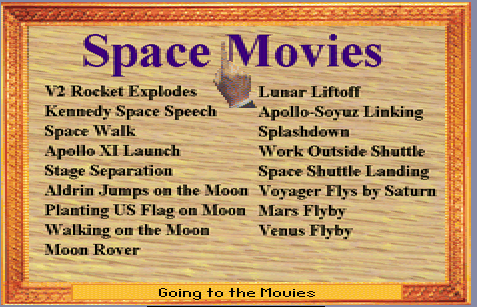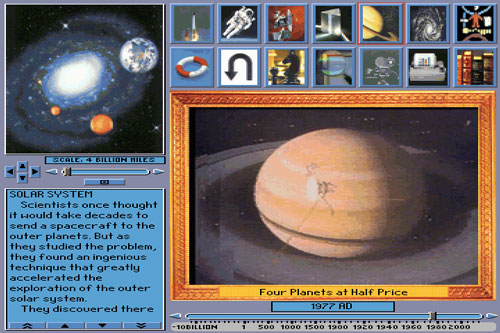I acquired a CD-ROM entitled Space Adventure by Knowledge Adventure (I like these people; they make decent, entertaining educational games). The physical media displays a copyright date of 1993, very early in the multimedia era.

This 1993 CD-ROM makes proud use of multimedia files. What kind? There’s a movies/ directory with 17 .mov files. It would be way too simple if these were QuickTime files, though. These represent a custom format, and video-only since a separate sounds/ directory contains .snd files with filenames corresponding to the .mov files. The .snd files are actually Creative Voice (a.k.a. VOC) files. As for this MOV format, wiki page and samples.

I was also surprised to find the binary ultrasnd.exe file among the drivers on the disc. The Gravis UltraSound was released in 1992. The sound setup utility does not have an option for the GUS, however. No matter since DOSBox has great SB/Pro/16 emulation.
I’m also a bit puzzled about why the DOSBox screenshots are 720 x 480 (posted here are various cropping and resizings).
The screenshots are 720×480 because the game used a VGA tweakmode, 360×480, which was the highest resolution you could get out of a stock VGA card in 256 colors.
Ah, what I used to know as Mode X. Thanks. I thought about that but couldn’t remember the details, and it seemed unlikely that an educational game would make use of it (I usually associated it with 1337 games and demos).
Should anyone attempt to reverse engineer the video format, this should serve as useful intelligence.
Mode-X “proper” was 320×240 with square pixels 3 video pages. 320×400 was a less-common variant, and 360×480 the least common, usually only seen in shareware games.
It’s possible to do all sorts of crazy stuff in stock VGA, like 400×300, 320×600 (great for faked RGB tweakmodes), or my personal favorite, 640×400 (1 page, all RAM used). But those were not as friendly to monitors, so you ran the risk of cutting out some of your audience.
You know what is very suspicious about those mov files? They all seem to start out with bytes almost exclusively in the printable range but further down very few correspond to printable characters.
Maybe the highest bit is used for indicating a compression using previous data…
Wonder what the first 4 characters “KAMv” stand for.
The initial repeating bytes may be some sort of dictionairy for a compressor. These repeating bytes end after the first 0xAB byte, which might be some sort of sync-point. After that sync-point, the bytes are more evenly distributed (compressed). However, 0x10, 0x20, 0x30, … are more common that the other values, the distribution looks like saw teeth. This may indicate a simple compression algorithm.
My guess on what KAMv stands for is Knowledge Adventure MoVie.